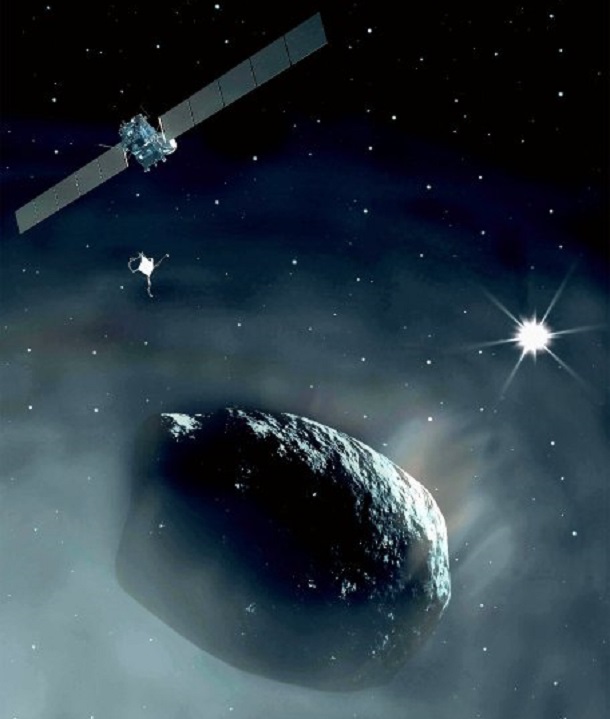Well two and a half years, far from the sun spent in deep sleep, the space probe “Rosetta”. Now you fear when Esa about whether she wakes up. The only way they can fulfill their goal to spy a distant comet. Even a landing is planned.
The object called 2007 VN 84 had hit the Minor Planet Center alarm. In November 2007, published by the organization that cares for the observation of asteroids and comets, the following warning: A previously unknown celestial bodies had appeared in the databases. Within a few days he will fill the earth come close to a record, even seemed a collision is not excluded. Several telescopes had spotted the cosmic ghost rider.
As it turned out soon, but it was not about a celestial body on a crash course, but the Esa-probe “Rosetta”. You should schedule get on our planet momentum for their trip to a distant comet. Astronomer Denis Denisenko recognized that, as first – and forced the asteroid finder to a correction: 2007 VN 84 has been deleted from the directories. Simultaneously, the “Rosetta” mission had gained worldwide attention.
And now the community of star gazers can look back on the probe: On Monday evening, “Rosetta” is to report back from hibernation, at least if everything goes according to plan. (A live audio stream you will find from 18 clock here) “I am convinced that ‘Rosetta’ wakes up ‘, says Gerhard Schwehm, Mission Manager at Esa. “And if it does not happen right away, we have plenty of time. You do not have the same after one or two hours are nervous.”
More than half an hour need the signals from the probe to the earth. The three 35-meter antennas of the European Deep Space Network will listen for them. But probably also the switched colleagues NASA will catch with their 70-meter dish in California’s Mojave Desert, the radio call sign first.
“Rosetta” is on the way to 1969 discovered comet Churyumov-Gerasimenko. Whoever finds the name too bulky, can gladly say “Tschuri”. The highly elliptical orbit around the sun led the airborne observatory, while in remote corners of the solar system, reaching almost to beyond Jupiter. There just comes to little radiation from the sun.
And because “Rosetta” gets its electricity by 64-square-meter solar cells, mission planners decided: Just about all systems on board from June 2011 off for exactly 957 days – until the distance to the sun fits again. This is now the case.
Esa-spacecraft “Rosetta””Philae” to investigate comet nucleus
“We’re getting closer to the sun and thus have more energy available,” says Esa-man Schwehm. “Rosetta” should therefore turn their solar panels in the direction of our central star – and align the antenna toward Earth. Thus, the radio contact is possible, on the one hopes at Esa-control center in Darmstadt so. From here, the Mission is controlled.
In May comes from Hesse and the command for the crucial course correction: Currently rushes “Rosetta” with a kilometer per second on the comet, after a braking maneuver, it should be no more than 200 meters per second.
In August, to “Rosetta” then pivot into orbit around its target. The celestial body that orbits the sun every six and a half years, has a diameter of about four kilometers. “Flying an orbit around the comet is quite complicated,” says Paolo Ferri, Head of the “Rosetta” mission operations at the Esa.
In photos of the “Hubble” telescope sees Tschurjumow-Gerasimenko from somewhat dented. Once every twelve and a half hours to rotate the chunk around itself well every one to two days must be corrected the path of the probe. For several months, should revolve around the comet and examine it with a dozen instruments “Rosetta”. For the 10th November is then the highlight of the mission planned: The probe is to send the lander “Philae” on the surface of Churyumov-Gerasimenko.
Such a hussar string has never been anyone daring. And the risk is very real that ” Philae ” too fast rumst on the surface – and despite securing only once bounces back into space. But if all goes smoothly, then to take the comet’s nucleus under the microscope ” Philae ” . Somewhere between two and a half days and six months long, depending on how long they hold out .
It was Tschurjumow -Gerasimenko actually only second choice in destinations for ” Rosetta ” . And easier -to-pronounce – – Actually the probe to the much smaller should comet Wirtanen fly . The fact that this did not come , has with the European launcher ” Ariane 5″ to do . There had to be blown up in flight after a failed launch in December 2002 with two satellites on board. Until experts had found the problem, Wirtanen could no longer be reached by the force of the rocket.
A new target was needed to be modified Lander . The launch was eventually displaced by more than a year . On its way to its goal is “Rosetta” now flown past two asteroids : Stone ( in September 2008) and Lutetia (July 2010). But the real highlight of the flight is yet to come . But for that , the probe needs to wake up again now for now.
[adrotate group=”8″]

